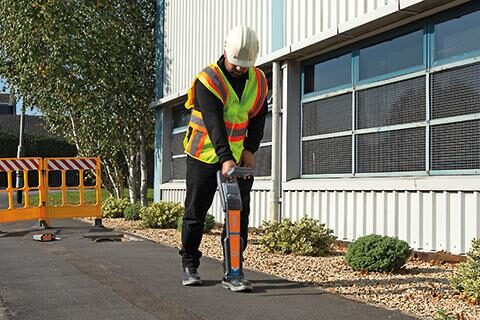
Electromagnetic detection for locating underground utilities is a widely used technique that relies on the principles of electromagnetic fields to detect and trace the paths of buried pipes, cables, and other infrastructure. This method is effective because many underground utilities, such as water pipes, gas lines, electric cables, and telecom wires, conduct electricity or have metallic components that can interact with electromagnetic fields.
Key Concepts of Electromagnetic Detection
- Electromagnetic Induction: The basic principle behind electromagnetic utility detection is induction. When an electromagnetic signal is applied to a utility, it induces a current in the conductive material (e.g., metal pipes, wires). A receiver can then detect the electromagnetic field produced by this current to locate the utility.
- Electromagnetic Signal Generation: A transmitter sends a low-frequency electromagnetic signal into the ground. If the signal encounters a conductive material, it induces a secondary electromagnetic field that can be detected by a receiver.
- Frequency Range: Different frequencies are used depending on the type of utility being located. Lower frequencies are typically used for larger utilities like water and gas lines, while higher frequencies may be used for smaller utilities like telecommunication cables.
- Active vs. Passive Methods:
- Active Detection: In active detection, the transmitter sends a signal into the ground, and the receiver detects the response. This is the most common method for locating utilities.
- Passive Detection: In passive detection, the receiver listens for existing electromagnetic signals, such as those from energized electrical lines or telecommunications systems.
Common Equipment Used in Electromagnetic Detection
- Electromagnetic Locators (Signal Generators and Receivers):
- A signal generator (transmitter) is placed above the ground and sends an electromagnetic signal into the ground.
- A receiver detects the electromagnetic fields generated by utilities in the area. The receiver provides information on the depth, position, and direction of the utility.
- Ground Penetrating Radar (GPR): While not strictly electromagnetic detection in the traditional sense, GPR uses high-frequency electromagnetic waves (radio waves) to detect changes in the subsurface. It can complement electromagnetic detection, especially when dealing with non-metallic utilities.
Process of Electromagnetic Detection
- Preparation: The area is surveyed to identify the location of the utilities. For active detection, a transmitter is placed on the ground surface above the utility.
- Signal Application: The transmitter sends an electromagnetic signal into the ground. The signal may travel along the utility lines or reflect off other subsurface features.
- Detection: A receiver, held on the surface or attached to a vehicle, detects the electromagnetic field generated by the utility. The receiver shows the location of the utility and may also indicate its depth and orientation.
Applications of Electromagnetic Detection
- Construction Projects: Locating utilities before excavation to avoid damage to underground infrastructure.
- Utility Maintenance: Helping utility companies to locate and repair damaged pipes, cables, or wires without unnecessary digging.
- Utility Infrastructure: Creating accurate maps of existing underground utilities, which is crucial for urban planning and future construction projects.
- Environmental Studies: Identifying the location of utilities in sensitive areas, like wetlands or historical sites, to avoid disturbances.
Advantages of Electromagnetic Detection
- Non-invasive: Unlike traditional digging, electromagnetic detection does not require excavation, minimizing the risk of damaging utilities.
- Efficiency: It allows for quick, precise location of utilities without the need for extensive digging.
- Cost-effective: Reduces costs associated with damages and unnecessary excavations.
- Safe: Helps prevent accidents by identifying potentially hazardous utilities like gas lines or electrical cables before they are disturbed.
Limitations of Electromagnetic Detection
- Non-metallic Utilities: Electromagnetic detection is less effective for non-metallic utilities (e.g., plastic water pipes), although complementary methods like GPR can be used.
- Depth Limitations: While electromagnetic detection is effective for shallow utilities, deeper utilities may require more powerful or specialized equipment.
- Interference: Nearby electrical systems or other sources of electromagnetic interference can sometimes affect the accuracy of the results.
Electromagnetic detection is an effective method for locating underground utilities, especially when combined with other techniques like Ground Penetrating Radar (GPR). It provides a non-invasive, efficient, and cost-effective way to map underground infrastructure, ensuring safety and precision during construction, maintenance, and urban planning projects.